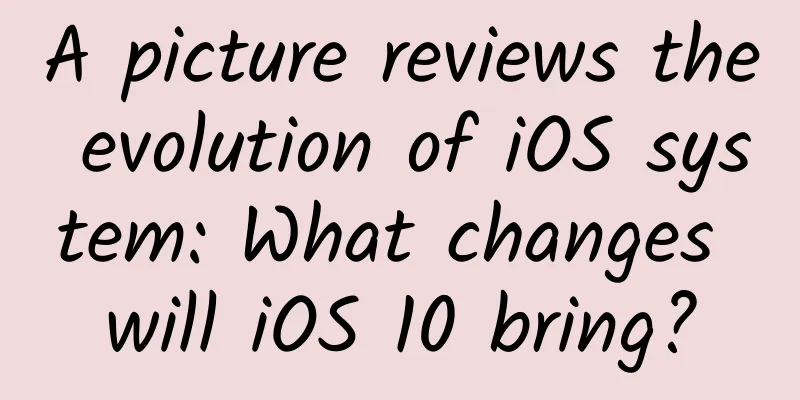A picture reviews the evolution of iOS system: What changes will iOS 10 bring?

|
On January 9, 2007, Apple held a press conference to launch the first generation of iPhone, and iPhone OS was released. Since then, iOS has begun to change the entire mobile field and the entire industry ecosystem, and has gradually become one of the most successful mobile operating systems in the world (the system was named iPhone OS in 2007, and was simplified to iOS in 2010. All systems in this article, regardless of version, are referred to as iOS). As of June 2016, iOS has undergone nine major changes, each of which brings surprises to users in terms of functions and UI, and even leads the development trend of the entire industry. Now, before the release of iOS 10, let us review the evolution of iOS together. iPhone OS 1: Hardware is not enough, software makes up for it In 2007, iPhone OS 1 was born with the first generation of iPhone. At that time, this operating system only had some basic applications and functions, and the iTunes and App Store that we are familiar with now had not yet landed on the iPhone. The first generation of iPhone actually had many limitations at the hardware level. It did not support 3G networks, multitasking, third-party applications, text copy and paste, desktop background changes, data sharing, etc. Such limitations completely shut out developers and hackers. Although the iPhone did not have an advantage in hardware and functions at that time, Apple's innovation and persistence in user experience also made it create many innovative moves. Its iOS user interface, capacitive touch screen, only retaining one physical button, the home button, completely interacting through touch, and the innovative Safari mobile browser all brought many surprises to users at that time. iPhone OS 2: App Store becomes a revolutionary application In 2008, Apple launched the iPhone 3G, and the iPhone OS was upgraded to the second generation. In this generation of the system, two major innovations laid a solid foundation for the future success of the iPhone. The first is the emergence of the App Store, which is definitely the most important killer application in the history of iOS development. iPhone users can not only browse and install applications on their phones, but also update the versions directly on their phones. At the same time, Apple has also built its own ecosystem based on the App Store. Whether it is applications, music or movies, users can directly enter their credit card information on their phones to pay for them. The second major update was the birth of the iOS SDK development kit. This generation of system was the first powerful development tool provided by Apple to iOS platform developers. With this development tool, even 3D games became extremely simple. Compared with other platforms, iOS application development has become more functional, better looking and more advanced. It was from this time that the powerful lineup of iOS platform applications began. iPhone OS 3: Check for gaps and improve details With the launch of iPhone 3GS in June 2009, this generation of iPhone OS 3 brought users more optimizations in details. This version of the system did not have any flagship features, but it filled in various gaps in the system through a large number of functions and application upgrades. In this generation of systems, Apple brought a new way of text selection, adding the functions of cut, copy and paste; the system also added spotlight search, allowing users to quickly enter text on the home screen for search; at the same time, the familiar "skeuomorphic" design style was also added during the release of this generation of systems. iOS 4: The multitasking iPhone 4 changes everything 2010 was a particularly important year in the history of iOS development. Apple launched the iPhone 4 that "changed everything" in that year, simplified the name of iPhone OS to iOS, and completely changed the system UI. From then on, the skeuomorphic design style officially became the mainstream in the industry. "Multitasking" is the biggest selling point of this generation of system. The multitasking mode means that the iPhone can provide a similar multitasking experience while being less affected by the memory occupied by background applications, and can still ensure good battery life and smooth performance. In the same year, Apple also released the iPad and optimized iOS 4 specifically for its operating characteristics. This was the first generation of iOS that spanned two products. Of course, this generation of the system brought more changes than just that, it also added innovative features such as FaceTime and folders. iOS 5: Function integration, Siri is born The 2011 iteration of iOS 5 brought numerous new features to integrate and complement the previous generation of the system. iOS 5 introduced features such as the Notification Center, iMessage, and iCloud, and also upgraded without a PC. For example, the activation of devices such as the iPhone and system upgrades no longer required a connection to a computer. However, the most eye-catching change in iOS 5 is the introduction of Siri voice assistant. This "virtual assistant" replaces the original voice control and brings some very interesting functional experiences. Siri allows users to ask questions and then gives suggestions in natural language. It can communicate with everything in the system and also supports text transcription, which leads the way for the design of mobile phone voice assistant functions in the industry. iOS 6: Patching and iterating as usual iOS 6 did not bring much surprise to users as a whole. Its main task was still to optimize the original system in various aspects and to make some improvements to various functions. It is worth mentioning that Apple gave up its cooperation with Google Maps in this generation of system and used its own maps. iOS 6 also launched the Passbook function, which began to provide users with mobile payment solutions. Users can centralize relevant payment information, such as tickets, boarding passes and coupons. iOS 7: A brand new look, leading the "flat" trend The emergence of iOS 7 has given the entire iOS system a new look. Led by Jony Ive, iOS 7 boldly abandoned the style of the Jobs era and brought major visual changes to the operating system. All the skeuomorphic, textured and flashing icons were discarded, and the overall style of iOS became more modern and flat, which also swept the entire industry. In addition to the UI innovation, iOS 7 also brings several innovative features. AirDrop allows users to easily share pictures, videos and other files with people around them; the camera has become more "professional" with the addition of filters and various parameter adjustments; the multitasking interface has also undergone tremendous changes; and Touch ID is also enabled on the system. iOS 8: More open, still focusing on detail optimization iOS 8 has not changed much in terms of UI, but it still has some interesting innovations in terms of functions, such as Apple Pay payment service, widgets, support for third-party input methods, new health applications, and opening Touch ID API to developers. In this generation of system, Apple has become more open and learned a lot of successful experience from its competitors. There are also more changes that focus on the optimization of the details of the original functions, such as the changes to iMessage, adding various functions such as voice, video, group chat, sharing, quick replies in the notification center, manual camera brightness adjustment, etc. iOS 9: The road to normalcy? iOS 9 also did not make much changes in appearance, but its functional changes were not obvious and did not bring many surprises to users. In this generation of system updates, Apple strives to make Siri, search and recommendation functions more intelligent, adding public transportation information and split-screen operation. Apple also modified the font of iOS and added a power saving mode. But overall, there are not many changes, giving users a sense of mediocrity. iOS 10: Waiting for more surprises At the Apple WWDC conference, which will open on June 14, 2016 (Beijing time), Apple will release its iOS 10 system. According to current news, in iOS 10, we will see the integration of Siri and third-party applications, improved HomeKit, Apple Pay, and further enhancement of Apple Music, etc. I hope that this time, Apple can bring us enough surprises. As a winner of Toutiao's Qingyun Plan and Baijiahao's Bai+ Plan, the 2019 Baidu Digital Author of the Year, the Baijiahao's Most Popular Author in the Technology Field, the 2019 Sogou Technology and Culture Author, and the 2021 Baijiahao Quarterly Influential Creator, he has won many awards, including the 2013 Sohu Best Industry Media Person, the 2015 China New Media Entrepreneurship Competition Beijing Third Place, the 2015 Guangmang Experience Award, the 2015 China New Media Entrepreneurship Competition Finals Third Place, and the 2018 Baidu Dynamic Annual Powerful Celebrity. |
<<: CEIDCO: 2024 Global Electricity Development Index Research Report
>>: Moto Z is priced lower than iPhone and will be launched in China in September
Recommend
This kind of fleshy lump in the stomach may turn into colon cancer! Check it out as soon as possible at this age...
Advice to friends over 40 years old Include colon...
Yutong Bus and Juefei Technology jointly launched autonomous driving technology for the first time in domestic passenger buses
Recently, Juefei Technology cooperated with Yuton...
Essential knowledge for Android development: I have a date with Gradle
0. Tell a story 0.1 Ant, I really thought you wer...
Price inquiry for Zhangzhou Aquatic Products Mini Program agent. How much is the price for Zhangzhou Aquatic Products Mini Program agent?
For entrepreneurs, although mini program developm...
Ledgers, Hounds, and Boars
Wang Youqin lost confidence in farming after thre...
Zuckerberg Q&A: Why do you force us to install Facebook Messenger?
[[122386]] Although FB holds Q&A events for t...
From being useless to being full of treasures, the rise of “fly ash”
Image source: Internet In the cold winter, northe...
The stronger the hot pot smell, the more additives it has? What is it that is stuck on your clothes?
Audit expert: Wang Guoyi Postdoctoral fellow in N...
Autohome: 2024 New Car Quality Report
The report is based on 24,301 qualified samples a...
Segment your users and how to conquer them one by one?
Today, we will talk about practical techniques fo...
Scientists, we want to tell you: 50th anniversary exhibition of China's overcoming the difficulties of hybrid rice
In 2023, it will be the 50th anniversary of China...
Chinese scientists made a major discovery! Where is the 270 billion tons of lunar water hidden?
There may be nearly 300 billion tons of water hid...
How to build user portraits for online education!
The implementation of the data-driven operation c...
Things that must be said about news promotion in the Internet era
With the rapid development of the Internet today,...
From science fiction to reality: How far are we from a world where “what you wish for can come true”? (Part 1)
Produced by: Science Popularization China Author:...









